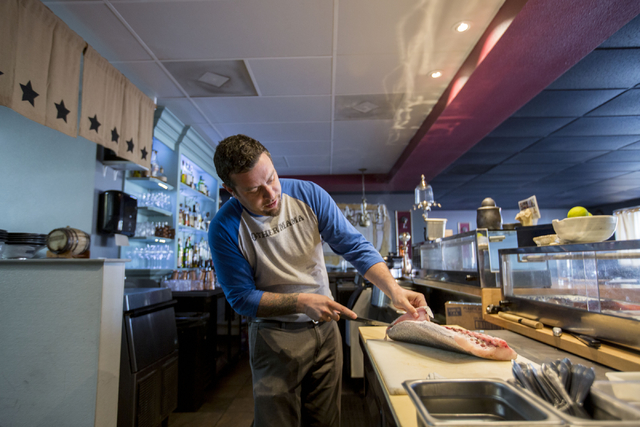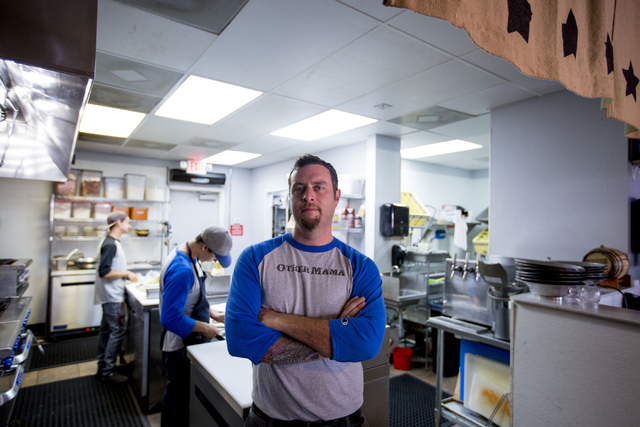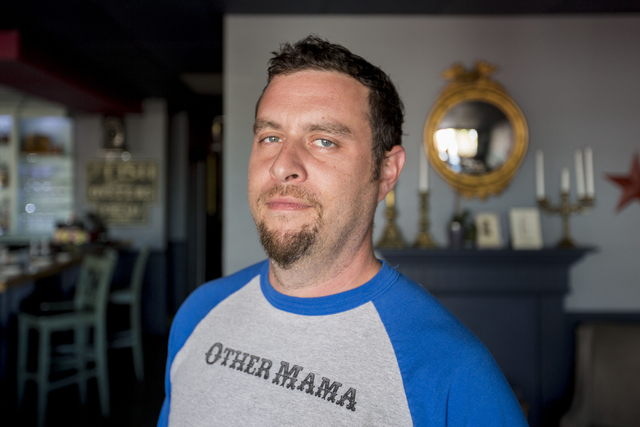Chef Dan Krohmer wants to share beauty of Japanese cuisine




Vegas Voices is a weekly question-and-answer series featuring notable Las Vegans.
After chef Dan Krohmer opened Other Mama at 3655 S. Durango Drive in March 2015, it quickly became one of the hottest tables in town, picking up accolades across the valley. Krohmer, a native of Placerville, California, began his career at a Japanese restaurant in Sacramento. While vacationing in Japan he connected with a friend whose family had a restaurant and ended up living there for almost two years. Krohmer used the time to learn even more about the country’s culture and cuisine, specifically sushi and the traditional multicourse kaiseki.
Review-Journal: What made you gravitate to Japanese cuisine in the first place?
Dan Krohmer: I was always just crazy about eating it as a kid. My dad’s a redneck but my mom’s from New York and had a lighter palate. We went out a lot, and I was always just kind of crazy about eating it, for some reason. I thought it was a different experience in Japanese restaurants; I liked the customer interaction. Also, I had an aunt from Okinawa that kind of got us interested as well.
R-J: How did you end up staying in rural Kumamoto, Japan for almost two years, when you hadn’t really planned it?
Krohmer: It was just day by day. I was at a loss. I was traveling at that time of my life. I’m not into the big city; I like the countryside with cherry-blossom trees and snow-covered mountains. I asked to stay. Three months turned into six, which turned into nine. I just worked to the point where they were sick of me and I was sick of them.
R-J: How has your background in Japanese cuisine influenced your attitude toward food in general?
Krohmer: I really have a strong feeling of mottainai, which basically is a (Japanese) term conveying a sense of regret about waste. That doesn’t mean just about food but yourself, your actions, your life — constantly being aware. They weren’t importing and exporting for a long time before World War II. They were forced to work with what they had. In Japanese culture, each vegetable is used in so many different ways, from the seeds to the skin to the stem. There isn’t a crazy amount of ingredients, like we use in the United States; at the end of the day, we don’t know how to use each one of them that well. Today, a lot of chefs are talking about food waste as a human problem. I think it’s something that really resonates even more now than ever.
R-J: What’s your mission at Other Mama?
Krohmer: There’s a personal mission: I wanted to establish for myself a way of life where I could have a foundation where people trust and respect what I do, make what we feel is appropriate and have a customer base to support that. I’m also very frustrated with the way Japanese restaurants have gone over the past five to 10 years, quantity over quality. Americans are turning sushi into what we turned Chinese food into, where we start ordering by the numbers, and things like yum yum sauce and putting Pop Rocks on something. I want Other Mama to slow things down a bit and understand why sushi came up in the first place, in terms of dealing with fresh product, seasonal product, the simple differences and variety of fish, not covering it with sauce and why this fish is better at this time of year. We try not to get too complicated in our dishes, in that we really want to celebrate the product and add as few things as possible, and amplify, not cover. We also want to start educating people about the diversity of fish. It’s not only better to eat but better for the environment and humanity.
R-J: How has your cooking style evolved over the years?
Krohmer: I feel as I’m getting order — I’m pushing 18 years now of doing this — I think the biggest thing that changes is your philosophy, when you think about your interaction with the customer and the staff. It’s not about you anymore, but how you are part of the community, using better suppliers and things that are going to in turn grow the whole cooking community in general.
R-J: You cooked for musicians at Coachella, on the Vans Warped Tour and other tours. What was that like?
Krohmer: It was the most fun and the most hard thing I’ve done in my life. My day started at 5 o’clock in the morning. I cooked in a kitchen set up in a 50-foot semi and had to do food for between 200 and 1,600 people. I would develop a different menu in every city and deal with a different supplier in every city. It was really intense, but I really enjoyed it. You’re disconnected. You kind of live in a different world.
Contact Heidi Knapp Rinella at hrinella@reviewjournal.com. Find more of her stories at www.reviewjournal.com, and follow @HKRinella on Twitter.
Getting to know: Dan KrohmerR-J: Favorite vacation destination?
Krohmer: Probably Tomales Bay, up in Marin County (California). It’s a coastal place, with oysters and Nieman Ranch beef. I’m not really a sit-on-the-beach guy.
R-J: Newest Las Vegas discovery?
Krohmer: Constantly just exploring more and more downtown, understanding the history. I’ve only been here three years. I’m trying to understand more the roots and the story of what happened here. I like hearing the stories about different neighborhoods and how they’ve evolved and changed.
R-J: What are you binge-watching?
Krohmer: I didn’t know “Narcos” was only two seasons. I jammed right through it. I was like, “Oh crap, it’s over?”











